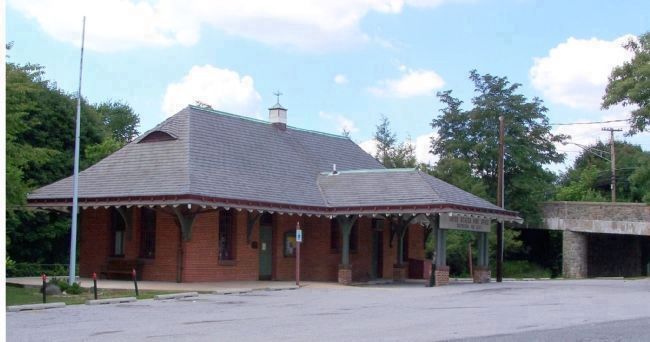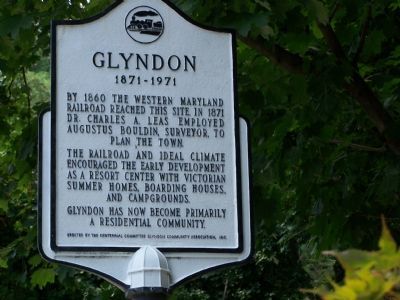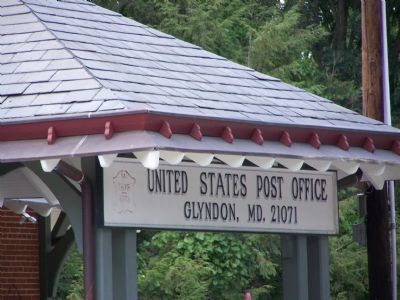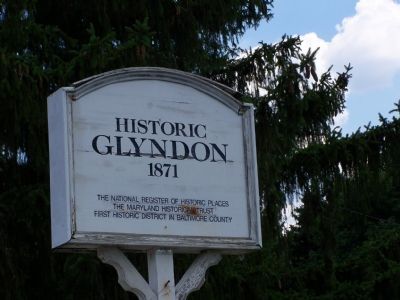Glyndon in Baltimore County, Maryland — The American Northeast (Mid-Atlantic)
Glyndon
1871–1971
Erected by Centennial Committee Glyndon Community Association, Inc.
Topics. This historical marker is listed in these topic lists: Entertainment • Railroads & Streetcars • Settlements & Settlers. A significant historical year for this entry is 1860.
Location. 39° 28.586′ N, 76° 48.992′ W. Marker is in Glyndon, Maryland, in Baltimore County. Marker is at the intersection of Butler Road (Route 128) and Central Avenue, on the left on Butler Road. Touch for map. Marker is in this post office area: Glyndon MD 21071, United States of America. Touch for directions.
Other nearby markers. At least 8 other markers are within 2 miles of this marker, measured as the crow flies. Emory Grove (approx. 0.2 miles away); Railroad Ave (approx. 0.2 miles away); Glyndon Station (approx. 0.2 miles away); “Buffalo Soldiers” (approx. 1.1 miles away); John and Margaret Reister (approx. 1.1 miles away); Colonel William Norris (approx. 1.1 miles away); Oldest High School in Baltimore County (approx. 1.1 miles away); Nicholson’s Manor (approx. 1.4 miles away). Touch for a list and map of all markers in Glyndon.
Also see . . .
1. Western Maryland Railway: Fireballs and Black Diamonds. (Submitted on May 2, 2008, by Tom Fuchs of Greenbelt, Maryland.)
2. The Western Maryland Railway in the Diesel Era. (Submitted on May 2, 2008, by Tom Fuchs of Greenbelt, Maryland.)
3. The Western Maryland Railway Story: A Chronicle of the First Century, 1852 - 1952. (Submitted on May 2, 2008, by Tom Fuchs of Greenbelt, Maryland.)
4. Western Maryland Diesels. (Submitted on May 2, 2008, by Tom Fuchs of Greenbelt, Maryland.)

Photographed By Beverly Pfingsten, August 12, 2007
4. Former Western Maryland Train Station at Glyndon
Glyndon was the junction of two lines of the Western Maryland Railway. The Main Line proceeded west through Westminster, MD and Thurmont, MD. The other line went further north and passed through Hanover, PA and Gettysburg, PA. This branch was nicknamed "The Dutch Line." The two lines come back together again in Blue Ridge Summit, PA.
The Main Line became part of the Maryland Midland Railway. The Dutch Line is now part of CSX Transportation and is known as The Hanover Subdivision (part of the Baltimore Division, which in turn is part of the Northern Region).
Both lines continue to see a limited amount of freight traffic. The Hanover Subdivision, for instance, only handles local freight trains between Baltimore MD and Hagerstown MD.
Passenger service on this part of The Western Maryland ended in the mid-1950's. Passenger service began at the Hillen Street Station in Baltimore. At the end, there was one train that went from Baltimore to Hagerstown. Another train went between Hagerstown and Cumberland. The Western Maryland was purchased by Jay Gould as the eastern section of his attempt to create a transcontinental rail line. The attempt failed.
The Main Line became part of the Maryland Midland Railway. The Dutch Line is now part of CSX Transportation and is known as The Hanover Subdivision (part of the Baltimore Division, which in turn is part of the Northern Region).
Both lines continue to see a limited amount of freight traffic. The Hanover Subdivision, for instance, only handles local freight trains between Baltimore MD and Hagerstown MD.
Passenger service on this part of The Western Maryland ended in the mid-1950's. Passenger service began at the Hillen Street Station in Baltimore. At the end, there was one train that went from Baltimore to Hagerstown. Another train went between Hagerstown and Cumberland. The Western Maryland was purchased by Jay Gould as the eastern section of his attempt to create a transcontinental rail line. The attempt failed.
Credits. This page was last revised on November 22, 2019. It was originally submitted on August 13, 2007, by Bill Pfingsten of Bel Air, Maryland. This page has been viewed 2,692 times since then and 43 times this year. Photos: 1, 2, 3, 4. submitted on August 13, 2007, by Bill Pfingsten of Bel Air, Maryland. • J. J. Prats was the editor who published this page.


